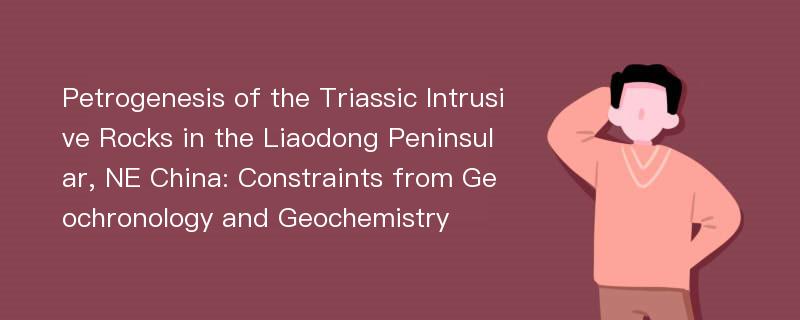
论文摘要
This paper carries out new whole-rock Major and trace elements, Sr-Nd isotopic, zircon U-Pb and Hf-O isotopic data for Late Triassic intrusive rocks of the Yinjian(YJ) syenite, Laojiandingzi(LJDZ) hornblende gabbro, Shuangdinggou(SDG) monzogranite and lamprophyre and Xiongdishan(XDS) syenogranite(Fig. 1), hornblende diorite and hornblende gabbro in the Liaodong Peninsular, NE China, aiming to constrain their petrogenesis and beginning age of lithospheric thinning of the northeastern North China Craton(NCC). New zircon laserablation inductivity coupled plasma mass spectrometry(LA–ICP–MS) U–Pb data indicate that the mafic rocks were emplaced during the Late Triassic(220 ~ 215 Ma), the alkaline rocks were emplaced during the Late Triassic(219 Ma), the granitic rocks were emplaced during the Late Triassic(219 ~ 211 Ma). The mafic rocks show relatively low SiO2(48.67 ~ 59.57 wt.%) and high MgO(2.62 ~ 7.31 wt.%) concentrations, with relatively high εHf(t)(-15.5 ~ 1.50) and δ18O(7.06 ~ 7.82 ‰), indicating they were formed by the partial melting of lithospheric mantle with different extent involvement of continental crust materials. The alkaline rocks display intermediate SiO2(63.33 ~ 65.55 wt.%), high Na2O+K2O contents(12.22 ~ 13.22 wt.%) and low MgO(0.12 ~ 0.28 wt.%) concentrations. They show intermediate(87Sr/86Sr)i(0.7064 ~ 0.7073), εNd(t)(-14.53 ~-14.79), εHf(t) value(-5.70 ~-11.7) values and relatively low δ18O value(5.49 ~ 6.37) values, together with their whole-rock geochemical characteristics, indicating they were originated from the partial melting of enriched lithospheric mantle metasomatized by melt melted by lower crustal material accompanied by the strongly fractional crystallization. In contrast, the granitic rocks possess relatively high SiO2(69.07 ~ 78.01 wt.%), Na2O+K2O(7.96 ~ 9.28 wt.%) and low MgO(0.11 ~ 0.89 wt.%) contents. They show two different kinds of isotopic data: the monzogranites relatively high(87Sr/86Sr)i(0.7085 ~ 0.7087), relatively low εNd(t)(-16.81 to-17.02), εNd(t)(-8.14 ~-8.98), εHf(t)(-17.9 ~-14.4), relatively high TDM2 model ages of 2165 ~ 2385 Ma and intermediate δ18O(6.10 ~ 6.95 ‰) values; the syenogranites have relatively high εNd(t)(-8.14 ~-8.98), εHf(t)(-3.40 to +1.20) values, relatively low TDM2 model ages of 1180 ~ 1405 Ma and relatively low δ18O(5.52 ~ 7.29 ‰) values, indicating that the monzogranites were derived from partial melting of ancient lower crust with relatively high extent contamination of mantle derived materials and syenogranites were derived from partial melting of juvenile lower crust. According to zircon U-Pb ages, geochemical data, Sr-Nd-Hf-O isotopic data and regional investigations, we conclude that the generation of the late Triassic intrusive rocks in the Liaodong Peninsular were most likely related to the collision between NCC and Yangtze Craton and the first exhumation of the subducted slab(Fig. 2). In addition, the collision is
论文目录
文章来源
类型: 国际会议
作者: QUAN Yikang,YANG Debin,YANG Haotian
来源: 第九届世界华人地质科学研讨会 2019-06-01
年度: 2019
分类: 基础科学
专业: 地质学,地质学,地质学,地质学
单位: College of Earth Sciences, Jilin UniversityKey Laboratory of Mineral Resources Evaluation in Northeast Asia, Ministry of Natural ResourcesKey Laboratory for Evolution of Past Life and Environment in Northeast Asia, Ministry of Education
分类号: P534.51;P588.12;P597.3
DOI: 10.26914/c.cnkihy.2019.028305
页码: 58-59
总页数: 2
文件大小: 294k
下载量: 1
